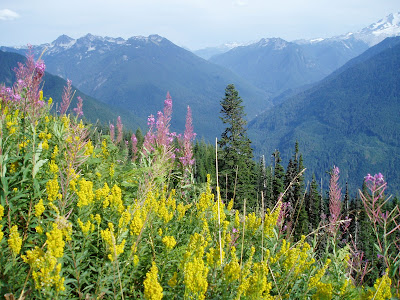 |
| Site locations (click to enlarge) |
If ever a mountain lived up to its name, Green Mountain is it. Emerging from the lowland forest at about 4500 feet (1370 meters) in elevation, hikers on
Green Mountain Trail 782 are treated to a spectacular 1.6 mile (2.6 km) wide by half mile high (0.76 km) meadow made green by bracken ferns, at least two species of
Rubus, and a variety of flowering herbaceous plants. Looking southeast across the Siuattle River from the Green Mountain meadows, Washington's most remote volcano,
Glacier Peak, is visible shouldering out over Lime Peak.
 |
Small Doug-fir stand in
Green Mtn Pasture |
 |
| Nobody home |
Our first stop of the day was at
Green Mountain Pasture at the mountain's base, where I tapped 50 fallen
Douglas-fir (
Pseudotsuga menziesii) cones from a small stand of trees growing within the pasture. Although I found an active agelenid web attached to one cone and the occasional spider retreat in others, I found no spiders in the cones.
 |
A western white pine cone dwarfs
neighboring Douglas-fir and
western hemlock cones |
 |
Its distinctive bark helped me
to locate the parent pine tree |
From there a 6 mile drive up the mountainside brought Rod Crawford and me to the Green Mountain trailhead. Hardly 10 minutes into our hike I spotted a few
western white pine (
Pinus monticola) cones lying next to the trail and located their source: a single pine tree growing in a forest dominated by western hemlock (
Tsuga heterophylla) and Douglas-fir. But as I've said before, all it takes is one good tree; I had no problem finding 50 fallen pine cones to tap. From them I collected 12 spiders and 2 species. Two-thirds of the spiders were
Cryphoeca exlineae (Hahniidae), a common litter species. The hemlock cones were so numerous and so much smaller than the pine cones that when I tapped pine cones, a hemlock cone would occasionally fall out.
 |
| Green Mountain meadow |
 |
| A mating pair of grasshoppers |
As numerous hikers have
noted on the
Washington Trails Association's Green Mountain page, the meadow is literally hopping with grasshoppers this time of year. Each step sets a dozen of them in motion. Many landed in my net by chance, but never lingered there long enough for me to photograph them. Only when the air cooled with the setting sun did they slow down enough for portraits.
 |
| Pika (Ochotona princeps) on rock |
 |
Misumena vatia hunting on
Anaphalis margaritacea |
I finally caught up with Rod in a little boulder-strewn draw on the eastern side of the mountain. He had already sampled conifer litter in a small grove of subalpine trees at its upper end, so I took the opportunity to tap a third set of cones from the same grove. From 50 tapped
mountain hemlock (
Tsuga mertensiana) cones I collected exactly zero spiders. Oh well. I did enjoy listening to the pikas calling "eep!" while I tapped those empty cones.
Be sure to read Rod's account of the day
here!

























